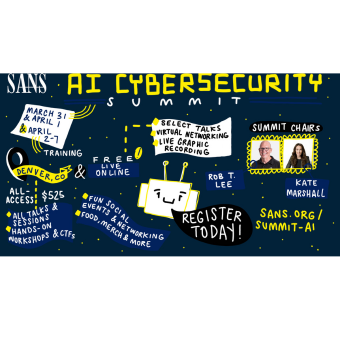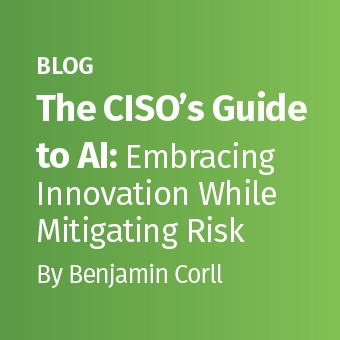Generative AI (GenAI) is becoming increasingly important across a variety of roles and industries, offering opportunities for growth as well as potential misuse. No clearer example can be found than in the realm of cybersecurity where this technology is reimagining the arms race between security enhancements and emerging threats.
While GenAI can significantly enhance security operations—from automating threat detection to crafting sophisticated defense mechanisms—it is also being leveraged by cybercriminals to develop advanced attack methods.
This dual-use nature of GenAI amplifies the necessity for cybersecurity professionals to be proficient not only in utilizing these technologies but also in anticipating and mitigating strategies employed by adversaries. Referencing the recently published 2024 CISO Primer paper, this blog explores effective strategies for upskilling and reskilling the cybersecurity workforce, emphasizing the importance of a continuous learning culture to stay ahead in this dynamic field.
Understanding the GenAI Landscape in Cybersecurity
The potential of GenAI extends beyond augmenting security measures; it also introduces complex challenges. Cybercriminals are using GenAI to create more convincing phishing emails, automate code generation for malware, and even mimic behavioral patterns to bypass biometric security systems. Recognizing these threats is crucial for developing a responsive cybersecurity strategy that integrates GenAI as an essential component of the cybersecurity curriculum.
Strategies for Upskilling and Reskilling
Tailored Training Programs: It is critical to develop training that covers both the defensive and offensive uses of GenAI. Such training programs should include real-world simulations where cybersecurity teams must counteract GenAI-driven attacks, providing hands-on experience in a controlled environment.
Collaboration with Academic Institutions and Tech Companies: By partnering with academia and technology firms, organizations can access the latest research and developments in GenAI, including those used maliciously. These collaborations can enrich training programs and ensure that they are as current as possible.
Certification and Continuous Education: Cybersecurity professionals should be encouraged to pursue advanced certifications that focus on AI and cybersecurity. The SANS Institute and Global Information Assurance Certification (GIAC) are reputable, world-class providers offering specialized training and certifications in areas critical to defending against and leveraging AI technologies. Continuous education through seminars, workshops, and courses on the latest GenAI developments is essential. Take a look at what resources are available to you and your team here.
Mentorship and Peer Learning: Implement a mentorship program that focuses on GenAI in cybersecurity. Experienced professionals who understand how to implement and counteract GenAI technologies can provide invaluable insights to less experienced staff, accelerating their learning curve.
Fostering a Culture of Continuous Learning
To effectively combat the misuse of GenAI by cybercriminals, fostering an organizational culture that prioritizes continuous learning and adaptation is essential. After all, this space is moving at a rapid clip. Here’s how to support this kind of culture:
Encourage Experimentation: Create opportunities for cybersecurity professionals to experiment with GenAI technologies. Sandbox environments, where employees can safely engage with both defensive and offensive uses of GenAI, can stimulate innovative thinking and problem-solving skills.
Recognize and Reward Learning Achievements: Recognize and reward efforts on your team that contribute to learning and mastering new GenAI skills, especially those that enhance the organization's defensive capabilities against GenAI-driven threats.
Provide Resources and Time: Allocate resources such as access to cutting-edge GenAI tools and time during working hours for teams to engage with these technologies. This not only helps professionals stay current but also benefits the organization by keeping its defensive strategies advanced and proactive.
Conclusion
Deploying GenAI in cybersecurity presents a new frontier for both enhanced security measures and potential vulnerabilities. Cybersecurity leaders must ensure their teams can not only use these technologies effectively but also anticipate and mitigate the sophisticated threats posed by cybercriminals using similar tools.
By investing in specialized training through respected institutions like the SANS Institute and GIAC, fostering strong partnerships for knowledge exchange, encouraging professional growth through certification, and promoting a proactive learning culture, organizations can prepare their cybersecurity workforce to face and utilize GenAI technologies competently and ethically. As the digital threat landscape evolves, so too must our approaches to securing it.
Whether you refer to it as “leading from the back,” where you encourage the use of GenAI by your team members, or you refer to it as “leading from the front,” where you show by example the acceptable use of GenAI within your organization, it’s important that AI is a part of your CISO leadership strategy in 2024. AI is a transformative trend that shows no sign of slowing down.
For more actionable guidance on implementing GenAI in your cybersecurity workforce operations, download the complete guide from SANS experts, SANS CISO Primer: 4 Cyber Trends That Will Move the Needle in 2024.

.jpg)



